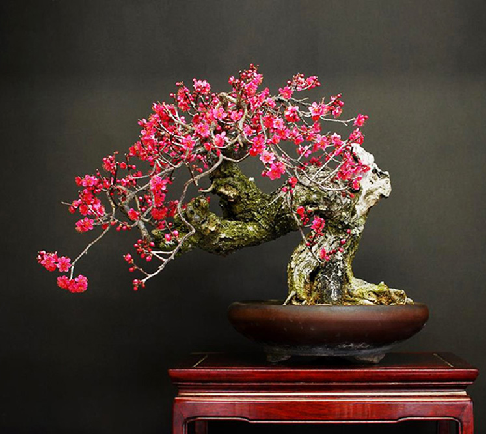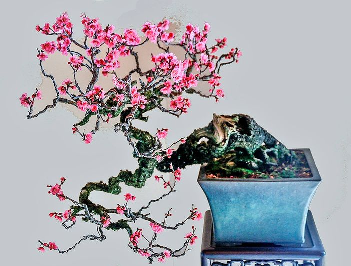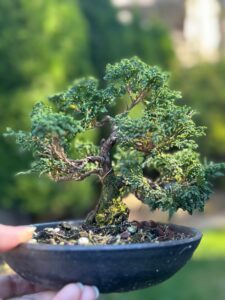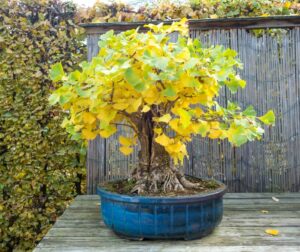
Japanese Flowering Apricot ( Prunus Mume )
The Japanese Flowering Apricot ( Prunus Mume ) dates back centuries into the Ming Dynasty. It is said to have originated around the Yangtze River in China and Korea, but for generations has been extensively cultivated in Japan. This distinct species is related to both the plum and the apricot. There are over 300 recorded Cultivars of Prunus Mume. It is known as one of the “Three Friends of Winter,” along with the Pine and Bamboo. Because of its late winter blossoming, the Japanese Apricot, like our poinsettia, is given as gifts around the New Year, and most are thrown out afterwards. Very sad because this tree makes a really nice bonsai.
Flowers appear before leaf buds form from mid-winter through late February. They can be single or double blossoms in colors of whites, pinks, reds, purples and even light green. Many times several of the colors appear together on the same tree. They are extremely fragrant therefore bringing sping into your garden or house during the winter.
Style: This tree is suitable for most styles except formal upright or broom.
Summer Placement: Full sun is best, but on scorching days a little afternoon diffused sun helps.
Winter Placement: Protect from hard frost to prevent twig dieback and flower damage. In our area, they can stand a light frost but need to be put into winter protection before hard frosts hit
Watering: Daily throughout the growing season. Sparingly in winter. Keep continuously moist from the time the flower buds begin to show to avoid bud and flower drop.
Feeding: Heavy feeding March through August results in more flowers in winter. Feed at least every 2 weeks throughout the summer, but this can be increased in amount and frequency as needed. Using organic fertilizer is best, starting with a higher nitrogen one and then later in August one higher in potassium and phosphate.
Wiring: Branches are brittle when lignified, so wiring is best done carefully and preferably on new growth early and trimmed as desired later. (Bjorn at Esei-en Bonsai has an excellent YouTube video on this and defoliating)
Pruning: Trim back hard after flowers have fallen, leaving at least 2-3 leaf buds. Leave all growth in summer and then trim back shoots again in early to mid-Autumn. This is a really fast grower—regular defoliating helps.
Repotting: Usually, every two to three years in late winter to very early spring as soon as flowering is done.
Propagation: This is done from hardwood cuttings in late winter, softwood cuttings taken in early spring and kept misted and grafting in winter or spring.
Pests and diseases: Aphids, verticillium wilt, scale, and spider mites. These can be treated with the appropriate insecticide or fungicide.
References: The International Bonsai Magazine, Bonsai Today, The Complete Book of Bonsai by Harry Tomlinson, Esei-en Bonsai. The books and magazines are available from our PSBS library.
written by Charlotte Field



